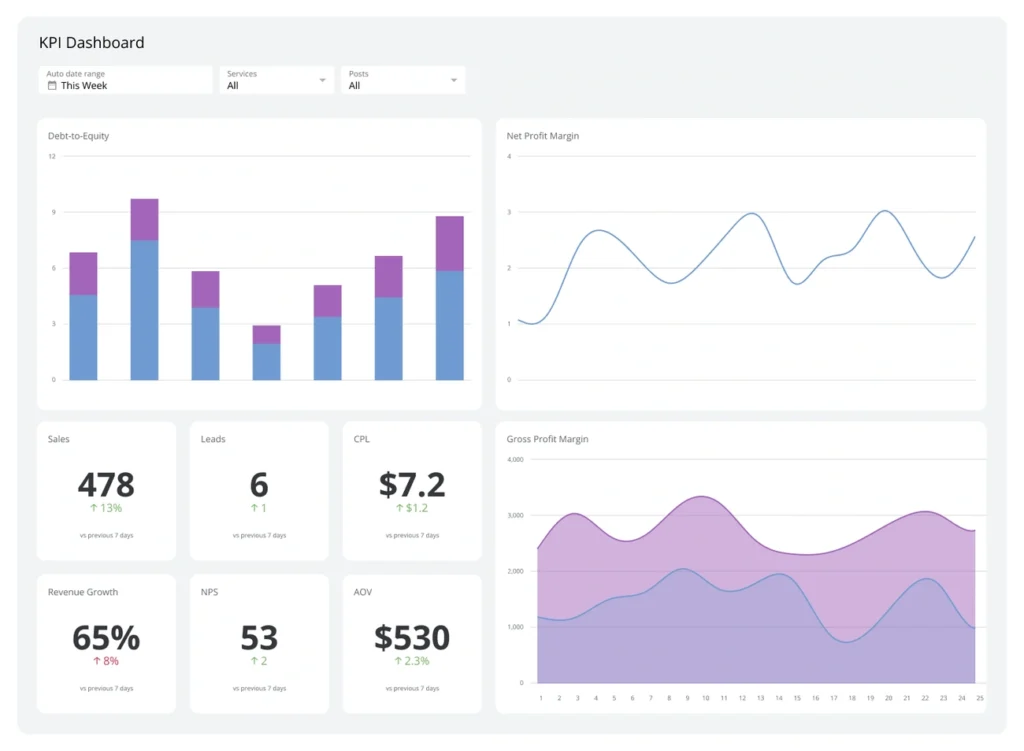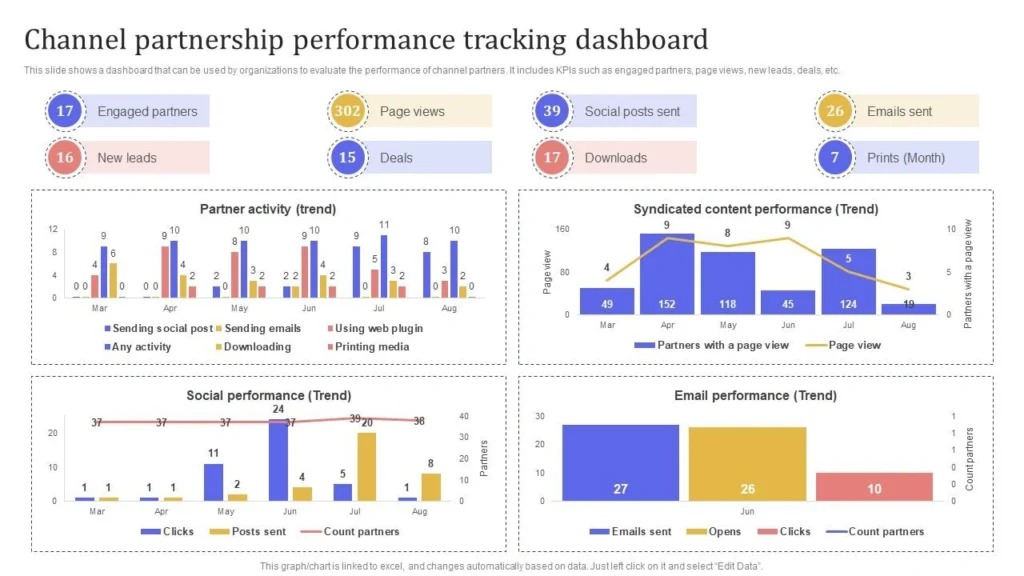Poor KPI tracking or complete lack of monitoring your partnerships can lead to missed chances and make it hard to solve problems.
Your business has put time and money into building mutually beneficial alliances. The question is – are they paying off? “What gets measured, gets done” remains true for entrepreneurs who want to make use of information from partnerships to propel development.
These partnerships bring tremendous value to your organization. Measuring their performance helps you make smart decisions about where to invest next. The right partnership KPIs let you spot top performers across segments. Your team can then fine-tune strategies and optimize resource allocation.
Mutually beneficial alliances serve as a crucial growth strategy in our interconnected world. Working without proper success metrics leaves you directionless. A partnership tracker that shows real results isn’t just useful – it’s vital.
This piece walks you through building a partnership tracker that gives meaningful insights instead of just gathering numbers. You’ll learn a clear system to set goals, pick metrics, create your template and turn data into partnership wins.
Step 1: Define Your Partnership Goals
“”The way to achieve your goals is step by step, you just need to build enough track, to be ahead of the train.”” — John Milton Lawrence, Business author and leadership expert
A partnership tracker starts with a clear understanding of your measurement goals. Successful partnerships need a shared vision that means more than words on paper. You must know what results you want before you can track them.
Clarify what success looks like
Every effective partnership needs partners who understand what success means. Harvard University’s John Kotter highlights that a shared vision is significant to drive success. All the same, this vision needs specific, actionable steps.
You should answer basic questions first: What do you want from this partnership? Do you seek to expand markets, create state-of-the-art opportunities, or improve operations? Research shows partnerships that line up closely deliver the best results.
Your organization’s immediate needs and future goals over the next eighteen to thirty-six months need attention to keep partners involved. This dual point of view helps partnership goals stay meaningful throughout the relationship.
Line up goals with business outcomes
Your partnership goals should support your overall business strategy. Research proves that matching vision, mission, core values, and goals helps reduce expensive turnover and speeds up shared outcomes.
Partners with matching goals can use their combined strengths and resources better. This leads to more state-of-the-art solutions, competitive advantages, and lasting growth. A solid framework for working together emerges from this alignment.
These aspects matter when matching partnership goals with business outcomes:
- Revenue generation and financial growth
- Market expansion or penetration
- Brand positioning and visibility
- Innovation and technology integration
- Risk reduction and resilience
You should review whether potential partners share your values. Different business values could wreck your partnership. Then, clear expectations in many areas become vital to select the right partners.
Set measurable partnership KPIs
Every big-picture goal needs measurable KPIs. To cite an instance, see how customer satisfaction improvements might track fewer complaints, quicker solutions, or better reviews.
Partnership KPIs fall into two categories:
- Strategic KPIs – These intangible performance measurements show business activity success and help reduce potential risks.
- Financial KPIs – These tangible metrics show partnership’s financial health through revenue, transaction frequency, and customer value.
Effective KPIs should follow the SMART framework—Specific, Measurable, Attainable, Relevant, and Time-bound. This method helps track, review, and adjust progress over time.
Partners should share information that measures activity success and contribution to larger goals. Sharing data about big picture goals allows everyone to analyze which actions turn vision into reality.
Clear partnership goals from the start create a foundation for a tracker that shows real results. Your measurement framework will focus on your business’s important aspects instead of collecting unnecessary data.
Step 2: Choose the Right Metrics to Track

Image Source: Klipfolio
Your next significant step after setting partnership goals is picking metrics that show real partnership performance. The partnership tracker should target specific KPIs that match your business goals and give useful insights.
Revenue and pipeline metrics
Your partnership tracker’s most basic metrics should measure direct financial effect. Partner-sourced revenue shows deals that partners bring directly, while partner-influenced revenue reflects how partners help speed up deals. These two metrics paint a complete picture of financial impact.
Pipeline metrics reveal upcoming partnership value. The total pipeline value from partnerships shows future revenue opportunities. Average deal size helps you assess transaction value and see how well partnerships work. Mature programs should focus on revenue as their North Star metric rather than lead volume to demonstrate actual financial returns.
Partner Lifetime Value (PLTV) offers deeper understanding by measuring your partners’ total value throughout the relationship. This calculation (Total Revenue – Partnership Costs – Length of Partnership × Cost per Year) shows which partnerships bring substantial long- term value.
Upsell and cross-sell performance
Great partnerships should boost customer value beyond their first purchase. Partners should know how to drive extra revenue through upselling premium versions and cross- selling complementary products.
Key metrics in this category include:
- Upsell/cross-sell rate: percentage of transactions that include these elements
- Revenue contribution: percentage of total revenue generated from these activities
- Portfolio adoption rates: how well partners promote your broader product offerings
Strong partners excel in these areas and show they can maximize customer lifetime value through strategic recommendations instead of just one-time sales.
Partner engagement and satisfaction
A detailed partnership tracker must look beyond money to assess relationship health. The Partner Satisfaction Index (PSI) gives vital insight into partner happiness and engagement. Regular surveys measure support quality, communication effectiveness, and goal arrangement.
Partner training completion rates, portal usage statistics, and marketing activity participation reveal partner investment levels. These behavior metrics predict future performance since highly engaged partners typically drive better results.
Mature programs benefit from a Net Promoter Score (NPS) that asks partners about recommending your program. This simple question often reveals overall satisfaction and areas needing improvement.
Strategic partnership KPIs to include
Your tracker should measure broader strategic effects. Joint sales pipeline metrics reveal potential revenue from shared efforts. Co-marketing contribution metrics show how partnership marketing drives awareness, leads, and revenue.
Other vital strategic KPIs include market coverage growth (showing expanded geographic or demographic reach), product adoption rates in the partner network, and customer retention rates for partner-managed accounts. These numbers show how partnerships help achieve long-term business goals beyond immediate revenue.
Customer satisfaction scores for partner-managed clients ensure quality service delivery. Comparing these scores with direct sales channels helps find best practices and improvement areas.
Step 3: Build Your Partnership Tracker Template

Image Source: SlideTeam
“”If everyone is moving forward together, then success takes care of itself.”” — Henry Ford, Founder, Ford Motor Company
Let’s create a partnership tracker template that captures and shows your data clearly now that you have defined goals and chosen metrics.
Select a tracking tool or platform
The right tool should match your organization’s needs and resources. While spreadsheets are still popular because they’re flexible, many companies now use more advanced options. Here are some choices to think about:
- Spreadsheet solutions – Excel and similar programs are easy to access. They offer advanced formatting options and can save you about 2 hours during setup.
- CRM-integrated tools – Tools that work with Salesforce or HubSpot help you sync data live and track attribution automatically.
- Dedicated partnership platforms – These specialized tools give you detailed features They include partner databases, automated reports, and ways to manage commissions.
The most important thing is to pick tools that work with your current systems. This helps data flow naturally between your partnership tracker and other business tools.
Design a clear and usable layout
The way you design your partnership tracker will make a big difference in how well it works. A good template needs these basic parts:
- Contact management section – Keep detailed partner information, communicatio records, and a history of interactions.
- Performance metrics dashboard – Show key data points visually so stakeholders can understand them quickly.
- Task and milestone tracking – Keep an eye on deadlines, deliverables, and project phases to meet partnership commitments on time.
- Financial overview – Keep records of transactions, investments, and revenue share with partners.
The information should flow logically with clear headings and consistent formatting. You might want to create reports that show partner revenue, lead generation, and customer satisfaction metrics.
Include filters for partner type and tier
You need to slice and analyze data in different ways to manage partnerships well. Add filters that let you:
- Sort partners by relationship type (direct partners vs. marketplace partners)
- See contract status to find pending proposals or agreements that will expire soon
- Group by country, state, or province to analyze geographic spread
- Organize partners based on performance tiers or how strategically important they are
These filters help you quickly spot top performers and partnerships that need more attention. They also make it easier to plan strategy and communicate with specific partner groups.
Your partnership tracker should be flexible enough to grow with your program. Many modern platforms let you customize by partner type. This supports different workflows for referral, reseller, technology, and service partners.
Step 4: Collect and Input Data Consistently
Your partnership tracker’s success depends on data quality and consistency. Even well- designed systems will fail without reliable information.
Automate data collection where possible
Manual data entry wastes time and leads to errors. Your CRM integration with the partnership management platform creates a two-way sync that gives you live access to data. This setup eliminates duplicate entries and keeps information fresh in all systems. You can automate several key areas:
- Performance reporting tools that show partner activities and program summaries instantly
- Commission calculations that process automatically based on set rules
- Survey and broadcast tools that collect stakeholder feedback on schedule
Set a regular update schedule
Old information damages trust and slows down your partnership network. You should review data quarterly to update contact details, engagement levels and other vital information. Your team should also meet with partners to discuss challenges that might affect timelines or data quality.
These regular check-ins help you keep records accurate and show partners you care about their success. Partners know they matter when you stay committed to their performance.
Ensure data accuracy and completeness
Data accuracy means having precise, correct information about channel partners’ performance, compliance and vital metrics. Here’s how to maintain high standards:
- Train your team to use standard formats for names, titles and other details
- Add validation processes that check against defined rules
- Clean data regularly to remove wrong, incomplete or duplicate information
- Use AI and machine learning tools to find errors faster
Accurate data makes your partnership tracker’s decisions reliable and useful. With precise information flowing into your system, you can extract meaningful insights in the next step.
Step 5: Analyze Results and Take Action
Data collection is just the start. The real value emerges from analysis and decisive action. Your partnership tracker becomes a powerful decision-making tool with proper usage.
Identify top-performing partners
The 80/20 rule applies to top-performing partners. A small percentage generates most of your partnership revenue. Your ecosystem’s MVPs stand out through key metrics like partner-sourced revenue, average deal size, and time-to-close.
We looked for partners who consistently beat goals and showed deep understanding of customer needs. Your tracker data helps you learn about these valuable relationships and create targeted initiatives that scale revenue. A company used this approach and saw monthly recurring partner revenue jump 104% in just one quarter.
Spot trends and areas for improvement
Partnership KPIs work best as living tools that grow with your ecosystem’s maturity. Dashboards or scorecards help visualize partner health through financial, operational, and engagement dimensions. This creates live visibility that supports hands-on management.
The best analysis balances quantitative metrics with qualitative feedback from sales teams, partner managers, and customers. Regular assessments plus partner feedback reveal what works and areas needing adjustment. Think over both short-term results (like leads and conversions) and long-term outcomes (such as brand equity and market positioning).
Use insights to optimize your strategy
Your partnership tracker reveals patterns that demand action. Make resource changes based on ROI trends and copy, apply, and extend strategies from successful partnerships. A mid-sized SaaS company revamped its tracking system and saw partner-influenced pipeline rise 22% with 30% higher win rates on co-sold deals in six months.
Set up a regular review schedule – monthly check-ins track tactical campaign performance while quarterly sessions focus on strategic planning. Open sharing of performance metrics with partners drives arrangement and motivation. Top performers deserve recognition and rewards while struggling partners need support.
Want to design a partnership strategy that delivers measurable results? Book your free strategy session today to learn how your partnership program can achieve these outcomes.
Remember – your partnership tracker should drive decisions, not just collect data. Smart usage turns partnerships from potential opportunities into proven revenue drivers.
Conclusion
A good partnership tracking system helps you know exactly how your collaborations are performing instead of just guessing. This piece shows you how to turn partnership data into useful business insights rather than collecting meaningless numbers.
Measuring partnerships correctly helps them succeed. Your partnership tracker needs clear goals that are the foundations for future success. The metrics you choose will show which partnerships create value and which ones need your attention.
Picking the right tracking tool can make a huge difference. Your system should expand with your partnership program, whether you use spreadsheets, CRM integrations, or specialized platforms. Quality data is crucial – automatic collection and regular updates help you make decisions based on accurate information.
Your partnership tracker should drive action, not collect dust. Regular analysis gives you the confidence to invest more in successful partnerships, fix struggling relationships, and improve your partnership strategy.
The key is putting your knowledge into practice. You can start small, but the important thing is to start now. A good partnership tracker proves ROI, helps allocate resources, and ended up turning partnerships from opportunities into proven revenue sources.

